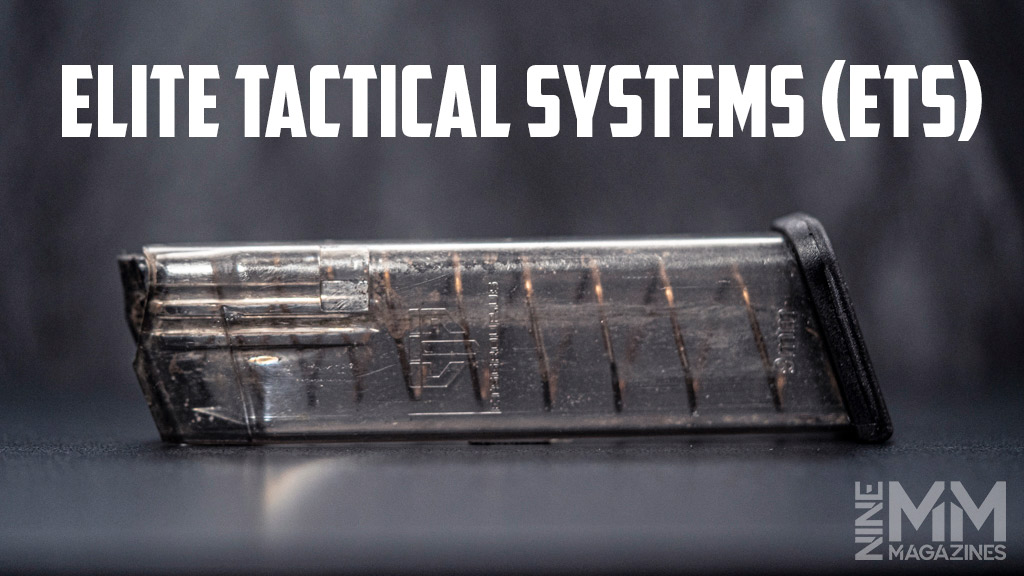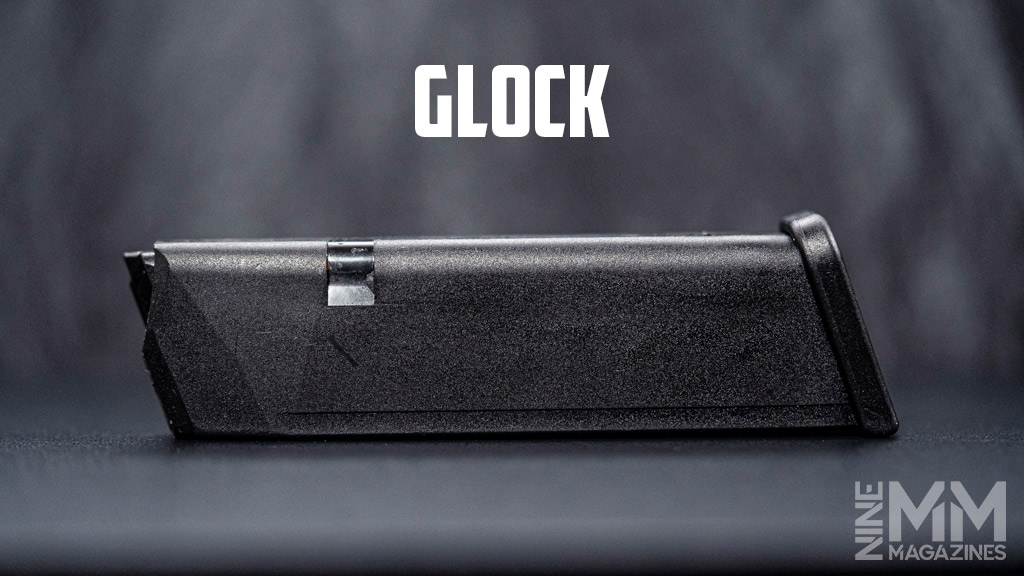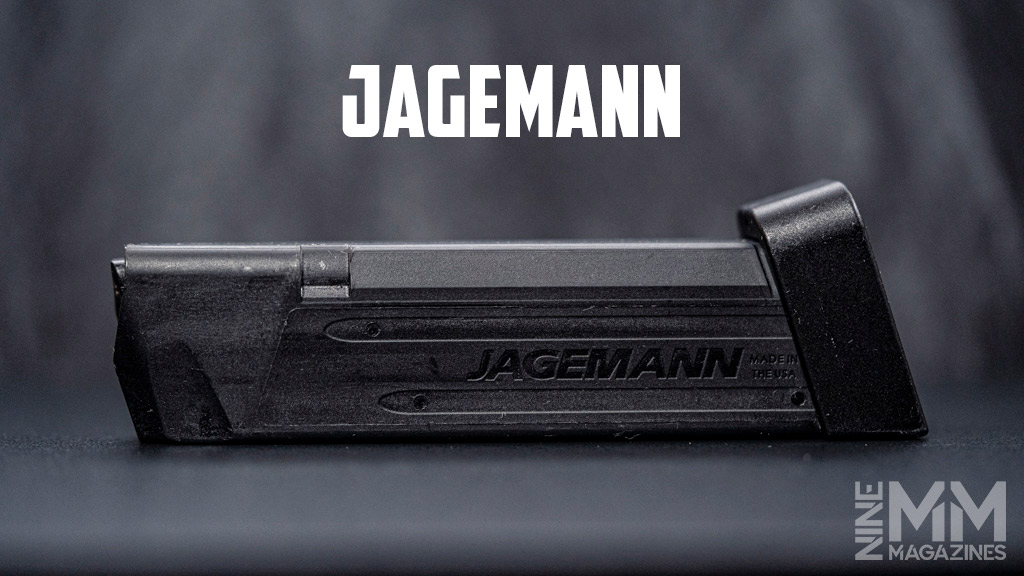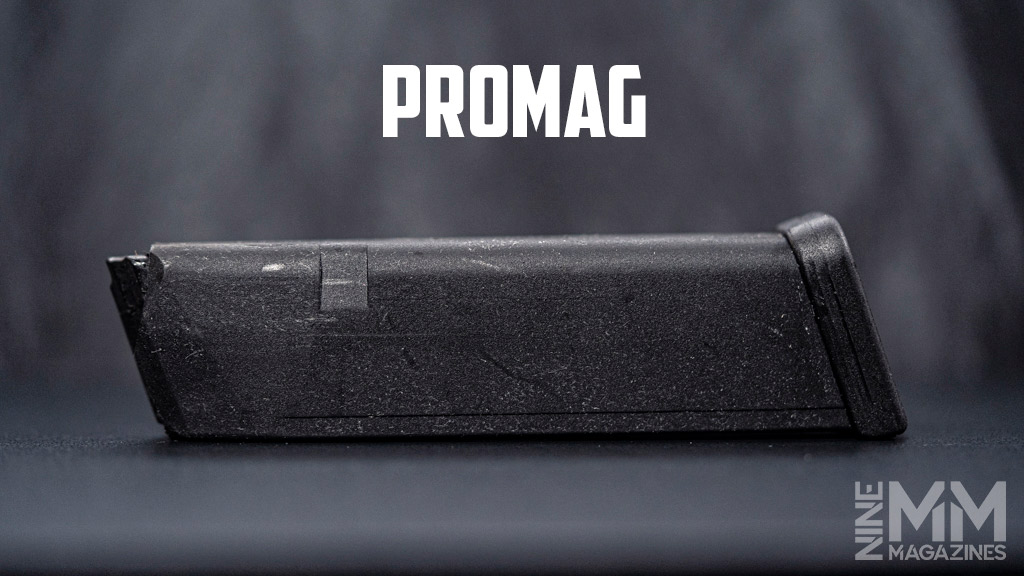
Glock 17 Magazine Test
Disclaimer: This page contains affiliate links, meaning we receive commissions for any purchases made through the links on this page.
Welcome to our Glock 17 magazine test. We’ll be testing some of the most popular Glock 17 magazine options available on the market. We’ve based our testing around common real-world scenarios. Our test gun is a Gen 5 Glock 17. We used Blazer Brass 9mm 115 FMJ ammo for our testing. It’s popular ammo that generally feeds well in a large variety of handgun magazines. We hope you find our tests helpful when making purchase decisions for your next magazine.
The magazines in our Glock 17 magazine test are listed below in alphabetical order by manufacturer. We’ve focused our testing on verifying manufacturers’ claims and confirming product reliability. We can’t test for everything, but we can provide you with reliable, consistent data. If you’re curious about our testing procedures, you can find them explained at this link. You can take a look at the models included in our test in the table below:
| MSRP | Manufactured In | Material | Capacity | Spring | Follower | Weight (Unloaded) | |
|---|---|---|---|---|---|---|---|
| Amend2 | $17.99 | USA | Polymer | 18 | Stainless | Anti-Tilt | 1.8 oz |
| Elite Tactical Systems (ETS) | $16.99 | USA | Polymer | 17 | Stainless | Anti-Tilt | 1.6 oz |
| Glock (Gen 4) | $24.99 | USA | Polymer | 17 | Stainless | Anti-Tilt | 2.7 oz |
| Jagemann | $11.99 | USA | Polymer | 17 | Stainless | Anti-Tilt | 1.9 oz |
| KCI | $14.99 | Korea | Polymer | 17 | Stainless | Anti-Tilt | 2.7 oz |
| Magpul | $12.95 | USA | Polymer | 17 | Stainless | Anti-TIlt | 1.6 oz |
| Promag | $19.99 | USA | Polymer | 18 | Chrome Silicon | Anti-TIlt | 2.8 oz |
| SGM Tactical | $18.95 | Korea | Polymer | 17 | Stainless | Anti-TIlt | 2.6 oz |
Amend2

Check out Amend2’s G17 magazine if you want a slightly higher-capacity mag than normal. It can fit 18 rounds as opposed to the standard 17, and it is made from an advanced polymer material to provide it with long-term durability. It’s lightweight and uses a non-memory and non-corrosive spring on the inside. Therefore, the magazine should be able to feed rounds into your Glock 17 consistently over and over.
This magazine features a unique baseplate that makes each model very easy to pull from your Glock 17, even if you have sweaty hands or need to do so on a timed shooting course. Plus, the magazine’s aesthetic is sleek and novel – these mags are easily distinguishable from others in your collection.
A matte black finish solidifies this magazine choice as a quality pick for any Glock 17 owner looking for something a little more novel and easy-to-use than average.
| Spring Tension | Fit/Feed Lip Spacing | Friction Test | Drop Test | Water Test | Sand Test | Soil Test | Crush Test (1K Lbs) | Crush Fail Test | |
|---|---|---|---|---|---|---|---|---|---|
| Amend2 | 7.53 Lbs | Good, .34″ | Pass, Slide Locks Open On Last Round | 1 Round Ejected | Pass, Slide Locks Open On Last Round | Fail, Failure To Feed | Fail, Failure To Feed | Pass, Slide Locks Open On Last Round | Failed at 1,900 Lbs |
Testing Overview
The Amend2 magazines are a budget-friendly solution for feeding your Glock 17. The build quality leaves something to be desired when compared to Glock factory magazines. That being said, the magazine we tested fed ammo well, and the slide consistently locked open on the last round. The Amend2 magazine passed our friction test but lost one round in our drop test. It handled being submerged in water in our environmental test but failed our sand and soil test with failure to feed malfunctions.
At 1,000 Lbs the Amend2 magazine showed minimal signs of damage. Everything still functioned correctly, ammo cycled, and the Glock 17 slide locked open on the last round. The Amend2 magazine stood up well to 1,900 Lbs of crush weight, lasting for several seconds before the base plate cracked in half and the spring began to exit the bottom. The magazine case showed minimal signs of damage. Small cracks were visible on the top, and bottom rear of the case.
Good For: Indoor and outdoor range use, environmental conditions involving water, basic gun training scenarios.
Not Good For: Environmental conditions involving sand, dirt, debris, and mud. Training scenarios where dropping magazines are a requirement.
Elite Tactical Systems (ETS)

ETS is Glock friendly – they provide multiple G17 magazines with different cartridge capacities. Available capacities are 17, 18, 19, 26, 34, and 45 rounds. Check out ETS’s store if you want a high-capacity magazine for your Glock 17 today. Each magazine comes with a clear polymer exterior, so you don’t have to rely on capacity indicator windows to know how many rounds you have inside. Just glance at the magazine and you’ll be able to tell!
It’s not the most durable magazine on the market, but the visibility is definitely a nice plus. The magazines are also quite easy to dissemble since they come with specially designed base plates. You’ll be up to take these apart with a minimum of tools, plus benefit from an ergonomically designed floorplate that makes each magazine easy to grab from your pouches. Lastly, each magazine comes with a lifetime warranty, covering you for replacements if there are any manufacturer defects.
| Spring Tension | Fit/Feed Lip Spacing | Friction Test | Drop Test | Water Test | Sand Test | Soil Test | Crush Test (1K Lbs) | Crush Fail Test | |
|---|---|---|---|---|---|---|---|---|---|
| Elite Tactical Systems (ETS) | 8.2 Lbs | Excellent, .34″ | Pass, Slide Locks Open On Last Round | 1 Round Ejected | Pass, Slide Locks Open On Last Round | Fail, Failure To Feed | Fail, Failure To Feed | Pass, Slide Locks Open On Last Round | Failed @ 1,500 Lbs |
Testing Overview
The Elite Tactical Systems magazines have the cool factor. They are made of clear polymer, allowing you to see if they are loaded at a glance. The build quality is good, they feel well made and have an excellent fit. The outer shell does not have a texture on it, causing it to feel slippery in wet environments. Ammo fed great, and the slide consistently locked open on the last round.
The friction test scuffed up the magazine’s finish, and we lost one round of ammo in our drop test. The Elite Tactical Systems magazine did not like sand, once it got between the follower and the interior wall, it locked the internals of the magazine up. The sand caused it to jam on the first round, rendering it unusable. The magazine faired better with dirt, but still had failure to feed malfunctions.
In our crush test, the baseplate of the magazine began to split at about 800 Lbs. The magazine itself was fine at 1,000 Lbs of force, it still functioned, and was able to cycle ammo. At 1,000 Lbs of force the slide consistently locked open on the last round. At around 1,500 Lbs, the case of the magazine failed. It did not split, it compressed and began to fold in on itself. The case material proved to be very strong, showing no cracks, splits, or splintering.
Good For: Indoor and outdoor range use, environmental conditions involving water, basic gun training scenarios.
Not Good For: Environmental conditions involving sand, dirt, debris, and mud. Training scenarios where dropping magazines are a requirement.
Glock Gen 4

Glock, of course, has an excellent magazine for its G17 pistols. Their standard-issue magazine has room for 17 cartridges, but it’s also one of the lightest magazines on the market. It only weighs about 10 ounces, allowing you to enjoy your Glock 17 at optimal performance even when fully loaded. The magazines are further bolstered by an advanced and durable polymer construction.
Each standard Glock magazine should last for a long time to come, regardless of the variety you choose. That’s right; there are additional varieties available. From the main Glock website, you can pick up a G17 magazine that can hold not just 17 cartridges, but also 19, 24, 31, and 33 cartridges depending on your needs. Therefore, Glock is one of the best sources for high-capacity G17 magazines on the market.
| Spring Tension | Fit/Feed Lip Spacing | Friction Test | Drop Test | Water Test | Sand Test | Soil Test | Crush Test (1K Lbs) | Crush Fail Test | |
|---|---|---|---|---|---|---|---|---|---|
| Glock Gen 4 | 8.3 Lbs | Excellent, .34″ | Pass, Slide Locks Open On Last Round | Pass | Pass, Slide Locks Open On Last Round | Pass, Slide Locks Open On Last Round | Pass, Slide Locks Open On Last Round | Pass, Slide Locks Open On Last Round | Failed @ 2,000 Lbs |
Testing Overview
It’s hard to beat the real thing, especially when it’s Glock perfection. The Gen 4 OEM magazine performed very well in our Glock 17 magazine test. The build quality, fit and finish are all excellent. It feeds ammo very well and passed our friction test with the slide consistently locking open on the last round. The magazine lost no rounds of ammo in our drop test, we believe the strong spring tension factored into that. The Glock Gen 4 magazine handled water, sand, and soil well.
At 1,000 Lbs the baseplate of the Glock Gen 4 magazine began making cracking sounds. However, once we pulled it off the press, it was still securely fastened to the magazine and functional. At 1,000 Lbs of force the magazine was fine, it still functioned and was able to cycle ammo. At 1,000 Lbs of force the gun’s slide still locked open on the last round. At 2,000 Lbs, the baseplate of the magazine folded and came off of the magazine. This caused the spring and internals to exit the bottom of the magazine.
The case of the magazine showed no signs of damage at 2,000 Lbs. We were able to install a baseplate from another Glock Gen 4 magazine and shoot with it. The magazine we crushed cycled ammo and allowed the slide of the Glock 17 to lock back after the last round.
Good For: Indoor and outdoor range use, environmental conditions involving water, sand, dirt, debris, and mud. Advanced gun training scenarios, and scenarios where dropping magazines are a requirement.
Not Good For: Gun owners on a tight budget.
Jagemann

The G17 magazine from Jagemann is unique. It’s created from a proprietary polymer that is scratch-resistant, even when dropped. It has an anodized finish carefully crafted from 17 thick coatings, which protect it from both blunt force damage and corrosive damage.
But the magazine is also great since it comes with an extended base pad, allowing you to quickly load the magazine into your Glock or retrieve it from a magazine pouch. It includes improved follower geometry and round staking to eliminate the possibility of jams or short feeds.
The magazine also boasts a self-lubricating design, which should help with smooth performance over the long-term. The magazine comes with a thumb notch to decrease your loading time when off the gun range, and it’s incredibly easy to disassemble so you can clean it thoroughly after every use.
All in all, there’s nothing this magazine doesn’t have or provide for Glock 17 owners. Consider this if you want a reasonably affordable and feature-rich magazine for your firearm.
| Spring Tension | Fit/Feed Lip Spacing | Friction Test | Drop Test | Water Test | Sand Test | Soil Test | Crush Test (1K Lbs) | Crush Fail Test | |
|---|---|---|---|---|---|---|---|---|---|
| Jagemann | 7.35 Lbs | Good, .34″ | Pass, Slide Locks Open On Last Round | 1 Round Ejected | Pass, Slide Locks Open On Last Round | Fail, Failure To Feed | Fail, Failure To Feed | Pass, Slide Locks Open On Last Round | Failed @ 1,900 Lbs |
Testing Overview
The Jagemann magazines are advertised as tough, but feel hollow when you pick them up. We also were not fans of the finger-pinching baseplate that comes standard. This budget-friendly magazine fed ammo well, passing our friction test and the slide consistently locking open on the last round. In our drop test, it lost one round. It passed the environmental water test but had failure to feed malfunctions in sand and soil.
In our crush testing the Jagemann magazine brushed off 1,000 Lbs of force. It took minimal damage, cycled ammo, and still allowed the test gun’s slide to lock back on the last round. At 1,900 Lbs, we saw the baseplate of the magazine fail, and the case begin to buckle. When we pulled it off of the press, the non-removable baseplate had been split in two and was no longer attached to the magazine. The back of the magazine had a crack going 3/4 the full length of the case.
Good For: Indoor and outdoor range use, environmental conditions involving water, basic gun training scenarios. Budget-friendly.
Not Good For: Environmental conditions involving sand, dirt, debris, and mud. Training scenarios where dropping magazines are a requirement.
KCI

KCI’s G17 magazine is a standard 17 round variety made of polymer materials. The polymer materials are bolstered by several steel components, such as a heat-treated chrome silicon internal spring wire. The magazine’s design makes it perfect to combine with many Glock mag accessories, and you’ll be able to use this magazine with Gen 3 or later Glock pistols.
For example, you can use these magazines with double-stack 9mm magazines, such as the double stack 19, 26, and 34 versions. Each magazine comes with tiered capacity windows so you’ll never have to guess as to how many cartridges you have left. The magazines are also designed for ambidextrous use, so consider these if you are left-handed and want a magazine that works well for your preferences for once.
| Spring Tension | Fit/Feed Lip Spacing | Friction Test | Drop Test | Water Test | Sand Test | Soil Test | Crush Test (1K Lbs) | Crush Fail Test | |
|---|---|---|---|---|---|---|---|---|---|
| KCI | 7.29 Lbs | Excellent, .34″ | Pass, Slide Locks Open On Last Round | Passed | Passed, Slide Locks Open On Last Round | Pass, Slide Locks Open On Last Round | Pass, Slide Locks Open On Last Round | *Pass, Slide Locks Open On Last Round (See Notes) | Failed @ 1,600 Lbs |
Testing Overview
The KCI magazine looks and feels like the Glock factory magazine. It has a rugged build and performed well in our Glock 17 magazine test. It feeds ammo without issue and passed our friction test with the slide consistently locking open on the last round. The magazine lost no rounds in our drop test. Its construction faired well in environmental testing, passing our water, sand, and soil tests.
At 1,000 Lbs, the baseplate of the magazine began to buckle. A raised formation appeared down the full length of the rear of the magazine. This told us the internals of the magazine were damaged. We were able to load six rounds of ammo into the magazine before the follower got stuck. We were able to cycle the six rounds that we loaded and the Glock 17 slide did lock back on the last round. Technically, the magazine was still functional, so we gave it a pass with an asterisk.
When we put the KCI magazine back on the press, it failed at 1,600 Lbs. The pressure caused the baseplate of the magazine to fold, and the spring and internals exited the bottom. The case of the magazine buckled, folding outwards, the rear of the magazine was completely compressed.
Good For: Indoor and outdoor range use, environmental conditions involving water, sand, dirt, debris, and mud. Advanced gun training scenarios, and scenarios where dropping magazines are a requirement.
Not Good For: Gun owners who are concerned about buying American-made products.
Magpul

Magpul also has a standard size G17 magazine. It has enough space for 17 cartridges and is made and engineered right in the USA. You can rely on this magazine for a long time due to its durability and long-term consistency. Magpul’s magazines are mostly constructed from special polymers, which provide them with greater resistance to corrosion and other types of damage. But they have additional high-quality features as well, like a high visibility tilt follower and a stainless steel spring. The stainless steel should prevent corrosion damage from affecting this component.
Each magazine comes with a removable floorplate so you can easily clean your magazines after using them on the range. An additional paint pen dot-matrix allows you to mark each magazine, and they come with several capacity indicator windows so you always know how many rounds you have left in the mag.
| Spring Tension | Fit/Feed Lip Spacing | Friction Test | Drop Test | Water Test | Sand Test | Soil Test | Crush Test (1K Lbs) | Crush Fail Test | |
|---|---|---|---|---|---|---|---|---|---|
| Magpul | 7.18 Lbs | Excellent, .33″ | Pass, Slide Locks Open On Last Round | 1 Round Ejected | Fail, Failure To Feed | Passed, Slide Locks Open On Last Round | Passed, Slide Locks Open On Last Round | Pass, Slide Locks Open On Last Round | Failed @ 1,800 Lbs |
Testing Overview
The Magpul G17 magazine has a tough, rugged build, it feels good in hand and runs ammo well. In normal use, the slide consistently locks open on the last round. It passed our friction test, but surprisingly, lost one round in our drop test. The Magpul G17 magazine failed our water test. The magazine is not ported in the back like many of its competitors. We suspect that the two small openings on the side of the magazine are too small to drain water efficiently. We tried several times, but could not get the magazine to cycle past the second round when water-logged.
The Magpul G17 magazine passed our environmental sand, and soil test. The tight .33″ feed lip spacing and anti-tilt follower were able to keep dust and debris out of the magazine’s inner workings. In our crush test, the Magpul magazine passed 1,000 Lbs of pressure with ease. Everything worked correctly, ammo cycled, the gun’s slide locked open on the last round.
At 1,800 Lbs, the baseplate of the magazine split in half. It remained attached to the bottom of the magazine, keeping the internals inside. A crack appeared in the case of the magazine, traveling 3/4 of the length of the magazine in the front and back. It should be noted that the crack in the case followed the seams of the magazine that were visible from its manufacturing.
Good For: Indoor and outdoor range use, environmental conditions involving sand, dirt, debris, and mud. Basic gun training scenarios.
Not Good For: Environmental conditions involving water. Training scenarios where dropping magazines are a requirement.
Promag

The Promag G17 magazine is lower capacity than average. It can fit 10 standard 9mm cartridges by default. But this may make it a great choice if you have a subcompact Glock 17 in your arsenal. It also fits several Glock 19 and Glock 26 models, providing further versatility.
The magazine body is made of a proprietary Zytel-based polymer, which provides it with added performance and durability over the long-term. Many of its parts are also designed with long-term reliability in mind, including the injection-molded magazine follower and the heat-treated chrome silicon wire spring. The spring and follower should both last for a long time to come even under heavy use.
The magazine body has a full-length steel insert for more structural integrity and durability. All in all, this magazine is a tough little accessory and a perfect pick if your G17 isn’t a standard size. The only downside is that it only comes with three very narrow capacity windows.
| Spring Tension | Fit/Feed Lip Spacing | Friction Test | Drop Test | Water Test | Sand Test | Soil Test | Crush Test (1K Lbs) | Crush Fail Test | |
|---|---|---|---|---|---|---|---|---|---|
| Promag | 6.83 Lbs | Good, .34″ | Pass, Slide Locks Open On Last Round | Pass | Pass, Slide Locks Open On Last Round | Fail, Failure To Feed | Fail, Failure To Feed | Pass, Slide Locks Open On Last Round | Failed @ 1,600 Lbs |
Testing Overview
The Promag magazine is another Glock factory clone that runs ammo well. It passed our friction test, and the slide consistently locks open on the last round. It passed our drop test, holding all of its rounds after hitting the concrete floor. The Promag G17 magazine passed our water test. However, sand, dirt, and debris were able to get inside in our environmental test, causing the magazine to lock up. It failed both our sand, and soil tests.
At 1,000 Lbs the Promag magazine performed well. The baseplate did begin to buckle, but it held on. The magazine cycled ammo, and the Glock 17’s slide locked open on the last round. At 1,600 Lbs, things changed, the baseplate flexed and came completely off. This caused the internals of the magazine to exit the bottom. The back of the magazine compressed completely, flattening the magazine between the steel plates.
Good For: Indoor and outdoor range use, environmental conditions involving water. Advanced gun training scenarios, and scenarios where dropping magazines are a requirement.
Not Good For: Environmental conditions involving sand, dirt, debris, and mud.
SGM Tactical

SGM Tactical’s G17 magazine holds 17 9mm cartridges by default and is made primarily of polymers. It has indicator windows at every level of the magazine, so you can roughly guesstimate how many cartridges you have left whether you’ve only fired a few or have almost emptied the mag.
The magazine is made from an impact-resistant polymer and features coated stainless steel springs plus steel reinforcing inserts. As a result, it’ll withstand thousands of rounds of action and should continue to work properly even if you drop it more than once.
Even better, this G17 magazine comes with a five-year warranty. You’ll get a free replacement for your magazine if there’s an issue with your purchase and the root cause is a manufacturer or material error. These magazines are some of the most affordably priced on the market, so they’re a good pick if you need a few spare mags for your G17 kit.
| Spring Tension | Fit/Feed Lip Spacing | Friction Test | Drop Test | Water Test | Sand Test | Soil Test | Crush Test (1K Lbs) | Crush Fail Test | |
|---|---|---|---|---|---|---|---|---|---|
| SGM Tactical | 6.8 Lbs | Good, .34″ | Pass, Slide Remained Closed On Last Round | 1 Round Ejected | Pass, Slide Remained Closed On Last Round | Pass, Slide Remained Closed On Last Round | Pass, Slide Remained Closed On Last Round | Pass, Slide Remained Closed On Last Round | Failed at 1,500 Lbs |
Testing Overview
The SGM Tactical magazine is similar to the Glock factory magazine in appearance and it runs ammo well. It passed our friction test, however, we were unable to get the slide to lock open after the last round with this magazine inserted. The magazine’s feed lip cutout allows the follower to push up on the trigger bar when advancing the next round as the gun is fired. There is also a metal insert in the right-hand side of the magazine grooves that lock into the pistol’s magazine release assembly. It’s possible that one, or both of these features were out of spec on our test magazine, causing the slide not to lock open after firing the last round.
It lost one round in our drop test. The SGM Tactical magazine passed our water, sand, and soil environmental tests. However, again, during the Glock 17 magazine test, the slide would not lock open after the last round.
The SGM Tactical magazine gave us some serious crunching noises at 1,000 Lbs. However, despite a bulge appearing on the spine of the magazine, it cycled ammo fine. It was difficult to eject the magazine from the gun, and the slide remained closed after the last round. At 1,500 Lbs the baseplate of the magazine failed and came off. It was still tight enough against the case to keep the internals inside, but no longer attached. The back of the magazine compressed, causing a convex bulge that rendered the magazine non-functional.
Good For: Indoor and outdoor range use, environmental conditions involving water, sand, dirt, debris, and mud. Basic gun training scenarios.
Not Good For: Training scenarios where quick reloads and dropping magazines are a requirement.
Glock 17 Magazine Test: Crush Testing
Crush testing involves discovering a product’s load limit. The amount of resistance a product can produce when compressed gives us a general idea of its load limit and how far we can push it until it reaches its breaking point. The breaking point may be a total collapse of the product’s form or a failure of weaker elements attached to the product. In our Glock 17 magazine test, we found the baseplates of most magazines to be the consistent breaking point. Had the baseplates of the magazines been stronger, it’s possible that the load limit of the magazines we tested could have been higher. Take a look at our Glock 17 magazine test results in the video above.
Final Thoughts

Can you have too many magazines? Modern gun owners practice hard and put a lot of rounds down range. Some guns are better than others for specific scenarios, and magazines are no different. In our testing data, you’ll find several magazines that are great options for plinking at the range. However, they don’t have the reliability to be used in a life or death situation. As always, be sure to test your own gear to ensure its compatibility before taking it out into the real world. Find out what works best for you, and your gun, before trusting your life with it.
Even the best magazines will wear out over time. Springs, followers, and baseplates can all be replaced, but worn feed lips or cracked shells are an indication that it’s time for a replacement. The data from our Glock 17 magazine test should help you to feel confident about making a purchase decision. We also highly recommend taking classes from certified instructors who are well respected in the gun community. Many times they can make recommendations to put you on the right path thanks to years of knowledge and experience.
Have a suggestion for our Glock 17 magazine test? Is there a magazine you’d like to see included in the testing? Send us a message using the contact form on the website!.

